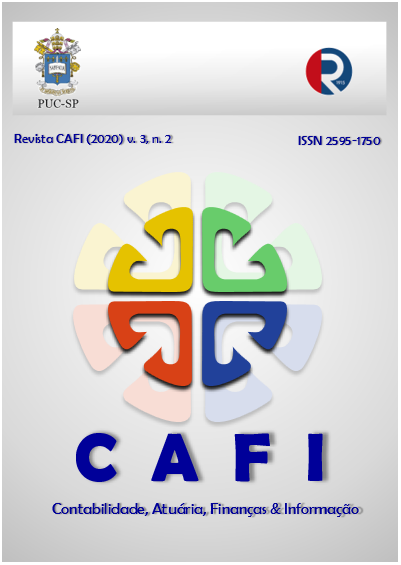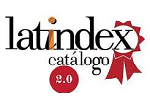Determinants of the capital structure of companies listed on the Argentina Stock Exchange: an empirical análisis of the period 2007 to 2016
DOI:
https://doi.org/10.23925/cafi.v3i2.48226Abstract
The study investigated Argentine companies to find out the determinants of the capital structure in relation to Trade-Off and Pecking Order Theories. With a quantitative approach, bibliographic, documentary, exploratory and explanatory research was used. The period was from 2007 to 2016 analyzing financial reports of 103 Argentine companies, extracted from the Economática database. The statistical tools were: descriptive analysis; Pearson's correlation; VIF; panel data regression (F from Chow; Hausman; LM from Breusch-Pagan). It is clear that Argentine companies have higher total, short-term and costly short-term debt. They have high averages in tangibility, return on assets, income tax, tax savings and profit volatility. Short-term debt in Argentine companies was highlighted with explanatory powers 80.2%. Current liquidity was highlighted, being significant in all indebtedness. Tangibility was not significant in long-term indebtedness and in the short and long-term costs of Argentine companies. In future research, other debt variables and their determinants are suggested, in addition to the speed of debt adjustment.
References
Abreu, A. F. (2004). Um estudo sobre a estrutura de capital e a política de dividendos considerando a tributação brasileira (Tesis de Maestría). Facultad de Economía, Administración y Contabilidad, Universidad de São Paulo, São Paulo. Recovered from: http://www.teses.usp.br/teses/disponiveis/12/12136/tde-28112005-173537/pt-
Altman, E. I. (1984). A further empirical investigation of the bankruptcy cost question. The Journal of Finance, 39(4), 1067-1089.
Bastos, D. D., & Nakamura, W. T. (2009). Determinantes da estrutura de capital das companhias abertas no Brasil, México e Chile no período de 2001-2006. Revista Contabilidade & Finanças, USP, São Paulo, 20(50), 75-94. Recovered from: http://www.scielo.br/pdf/rcf/v20n50/v20n50a06.pdf
Bauer, M. W., & Gaskell, G. (2002). Pesquisa qualitativa com texto, imagem e som: um manual prático. Petrópolis: Vozes.
Baxter, N. D. (1967). Levarage, risk of ruin and de cost of capital. The Journal of Finance, 22(3), 395-403.
Berger, P. G., Ofek, E., & Yermack, D. L. (1997). Managerial Entrenchment and Capital Structure Decisions. The Journal of Finance, 52(4), 1411-1438.
Berlingeri, H. O. (2006). U-shaped cost of equity function? Digging into Modigliani-Miller (1958) mistake. Recovered from: http://dx.doi.org/10.2139/ssrn.934550.
Bessler, W., Drobetz, W., & Kazemieh, R. (2011). Factors affecting capital structure decisions. Capital Structure and Corporate Financing Decisions. Hoboken, NJ: John Wiley, 17-40.
Bhattacharya, S. (1988). Corporate finance and the legacy of Miller and Modigliani. The Journal of Economic Perspectives, 2(4), 135-147. Recovered from: https://www.rose-hulman.edu/~bremmer/EMGT/paper/bhattacharya.pdf.
Brealey, R. A., Myers, S. C., & Allen, F. (2010). Principles of corporate finance. New York: McGraw-Hill Irwin. Recovered from: http://www.competitiontribunal.gov.au/__ data/assets/pdf_file/0004/28246/END.042.001.0013.pdf.
Brennan, M. Kraus, A. (1987). Efficient Financing under Asymmetric Information. Journal of Finance, 42, 5, 1225-43. Recovered from: http://links.jstor.org/sici?sici=0022-1082%2819871 ... O%3B2-5&origin=repec
Bowman, E. H. (1980). A risk/return paradox for strategic management. Sloan Management Review, 21, 17-31.
Caglayan, E., & Sak, N. (2010). The determiants of capitl structure: evidence from the Turkish Banks. Journal of Money, Investiment and Banking, (15), 57-65.
Cameron, A. C., & Trivedi, P. K. (2005). Microeconometrics: methods and applications.
Cambridge: Cambridge University Press.
Cooper, D. R., & Schindler, P. S. (2003). Métodos de pesquisa em administração. Porto Alegre: Bookman.
Copeland, T., Weston, J, & Shastri, K. (2005). Financial Theory and corporate policy. USA: Pearson.
Correa, C. A. (2006). A Estrutura de capital das maiores empresas brasileiras: análise empírica usando Painel Data (Tesis de Maestría). Universidad Presbiteriana Mackenzie, São Paulo. Recovered from: http://tede.mackenzie.br/jspui/handle/tede/517.
Correa, C. A., Basso, L. F. C., & Nakamura, W. T. (2013). A estrutura de capital das maiores empresas brasileiras: análise empírica das teorias de Pecking Order e trade-off, usando panel data. RAM, Rev. Adm. Mackenzie [online], 14(4), 106-133. Recovered from: http://dx.doi.org/10.1590/S1678-69712013000400005.
Daher, C. E. (2004). Testes empíricos de teorías alternativas sobre a determinação da estrutura de capital das empresas brasileiras (Tesis de Maestría). Brasília: UnB, UFPB, UFPE, UFRN.
Demirgüç-Kunt, A., Peria, M. S. M., & Tressel, T. (2020) The global financial crisis and the capital structure of firms: Was the impact more severe among SMEs and non-listed firms? Journal of Corporate Finance, 60, Febr. Recovered from: https://doi.org/10.1016/j.jcorpfin.2019.101514
Durand, D. (1952). Cost of debt and equity funds for business: trends and problems in measurement. In: Conference on Research in Business Finance (1952). Proceedings…, New York, National Bureau of Economic Research, 215-262.
______. (1959). The Cost of Capital, Corporate Finance, and the Theory of Investment: Comment. The American Economic Review, 4, 639-55.
Fama, E., & French, K. (2002). Testing Trade-Off and Pecking Order Predictions about Dividends and Debt. The Review of Financial Studies, 15(1), 1-33. Recovered from: http://www.jstor.org/stable/2696797.
Frank, M. Z., & Goyal, V. K. (2008). Trade-off and pecking order theories of debt. In: Eckbo, B. E. (2008). Handbook of Corporate Finance: Empirical Corporate Finance, 2. North-Holland: Elsevier. 135-202.
Gaud, P., Jani, E., Hoesli, M., & Bender, A. (2005). The Capital Structure of Swiss Companies: an Empirical Analysis Using Dynamic Panel Data. European Financial Management, 11(1), 51-59. Recovered from: https://doi.org/10.1111/j.1354-7798.2005.00275.x.
Harris, M., & Raviv, A. (1991). The theory of optimal capital structure. Journal of Finance, 48, 297-356.
Hegenberg, L. (1976). Etapas da investigação científica. São Paulo: EPU-EDUSP.
Hsiao, C. (2005). Why Panel Data?. IEPR Working Papers 05.33, Institute of Economic Policy Research (IEPR). Recovered from: https://papers.ssrn.com/sol3/papers.cfm?abstract_id=820204.
Heinkel, R., Zechner, J. (1990). The Role of Debt and Perferred Stock as a Solution to Adverse Investment Incentives. Journal of Financial and Quantitative Analysis, 1990, 25, 1, 1-24. Recovered from: https://www.cambridge.org/core/product/identifier/ ... type/journal_article
Hovakimian, A., Opler, T., & Titman, S. (2001). The debt equity choice. Journal of Financial and Quantitative Analysis, 36(1), 1.
Hovakimian, A., & Li, G. (2011). In search of conclusive evidence: How to test for adjustment to target capital structure. Journal of Corporate Finance, 17, 33-44. Recovered from: https://econpapers.repec.org/article/eeecorfin/v_3a17_3ay_3a2011_3ai_3a1_3ap_3a33-44.htm.
Mehran, H. (1992). Executive incentive plans, corporate control and capital structure. The Journal of Financial and Quantitative Analysis, 27(4), 539-560.
Mendonça, F. F. P., Martins, H. C., & Terra, P. R. S. (2019). Estrutura de Capital e Mecanismos de Governança Externos à Firma: Uma Análise Multipaís. Revista de Administração Contemporânea. v. 23, n. 6, 765-785. Recovered from: http://doi.org/10.1590/1982-7849rac2019100109
Modigliani, F., & Miller, M. (1958). The cost of capital, corportation finance and the theory of investment. The American Economic Review, 433-443.
Modigliani, F., & Miller, M. (1961). Dividend politicy, growth and the valuation of shares. Journal of Business, 411-433.
Modigliani, F., & Miller, M. (1963). Corporate Income Taxes and the Cost of Capital: A Correction. The American Economic Review, 53(3), 433-443. Recovered from: https://www2.bc.edu/thomas-chemmanur/phdfincorp/MF891%20papers/MM1963.pdf.
Myers, S. C. (2001). Capital structure. The Journal of Economic Perspectives, 15(2), 81-102.
______. (1984). The capital structure puzzle. The Journal of Finance, 39(3), 575-592.
Myers, S. C, & Majluf, N. (1984). Corporate Financing and Investment Decisions When Firms Have Information that Investors Do Not Have. Journal of Financial Economics, 13(2), 187-221.
Nakamura, W. T., Martin, D. M. L., Forte, D., Filho, A. F. C., Costa, A. C. F., & Amaral, A. C. (2007). Determinantes de estrutura de capital no mercado brasileiro: análise de regressão com painel de dados no período 1999-2003. Revista Contabilidade & Finanças, 18(44), 72-85. Recovered from: https://dx.doi.org/10.1590/S1519-70772007000200007.
Narayanan, M. P. (1988). Debt versus equity under asymmetric information. Journal of Financial and Quantitative Analysis, 23, 39-51.
Ross, S. A., Westerfield, R. W., & Jordan, B. D. (2008). Administração financeira. São Paulo: MCGraw- Hill.
Scott, David F., Jr., and John D. Martin, 1975, Industry influence on financial structure, Financial Management 4, 67-73.
Shyam-Sunder, L, & Myers, S. C. (1999). Testing static tradeoff against pecking order models of capital structure. Journal of Financial Economics, 51(2), 219-244. Recovered from: https://pdfs.semanticscholar.org/8ecf/61595b42ad97df818edecd79e1b1719e02a5.pdf.
Smith, C., & Warner, C. (1979). On financial contracting: an analysis of bond convenants. Journal of Financial Economics, (7), 117-161.
Stanley, P., & Gale, C. (2012). The miller-modigliani 1961 ponzi scheme, alias "dividend irrelevance". International Journal of Law and Management, 54(3), 234-241. Recovered from: http://dx.doi.org/10.1108/17542431211228638.
Stonehill, A., Beekhuisen, T., Wright, R., Remmers, L. (1975) Financial goals and debt ratio determinants: a survey of practice in five countries. Financial Management, p. 27-33. Recovered from: https://www.jstor.org/stable/3665187
Tapia, G., & Albornoz, C. (2017). Tratado de finanzas, negocios, empresas y organizaciones. Buenos Aires: Thomson Reuters.
Titman, S., & Wessels, R. (1988). The determinants of capital structure choice. Journal of Finance, 48(3).
Warner, J. B. (1977). Bankruptcy costs: some evidence. The Journal of Finance, 32(2), 337-347.
Weston, J. F., & Brigham, E. (1981). Managerial finance. Hinsdale: Dryden Press.
Wooldridge, J. M. (2009). Introductory Econometrics: A modern Approach. Cengage Learning.
Downloads
Published
How to Cite
Issue
Section
License
Declaração de Direito Autoral
Autores mantém os direitos autorais e concedem à revista o direito de primeira publicação, com o trabalho simultaneamente licenciado sob a Licença Creative Commons Attribution que permite o compartilhamento do trabalho com reconhecimento da autoria e publicação inicial nesta revista.
Declaração de Privacidade
Os nomes e endereços informados nesta revista serão usados exclusivamente para os serviços prestados por esta publicação, não sendo disponibilizados para outras finalidades ou a terceiros.









